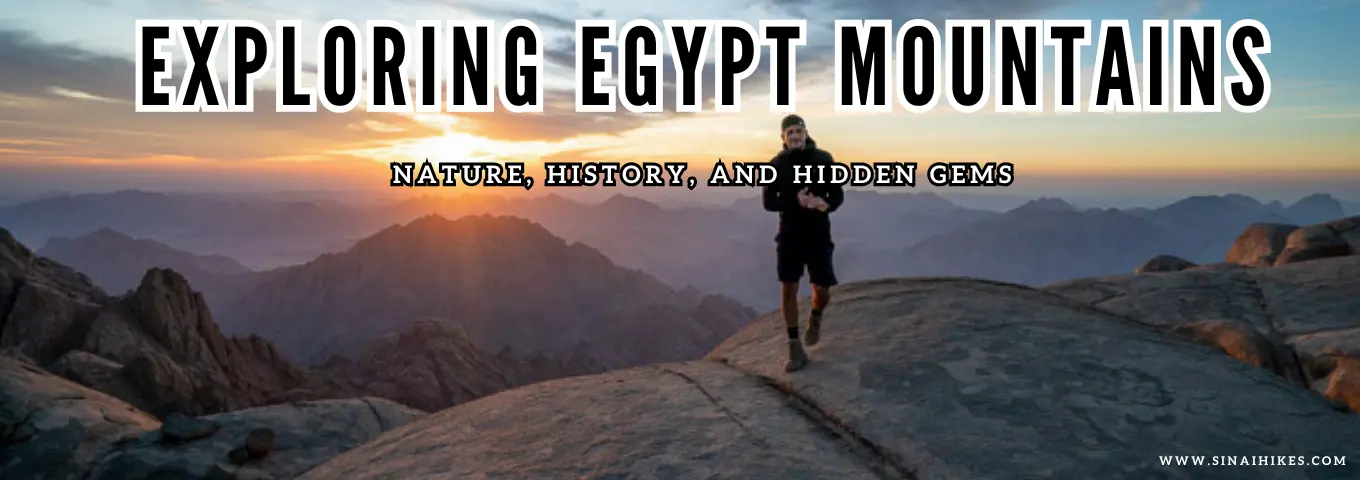
Exploring Egypt Mountains: Nature, History, and Hidden Gems
24 Jun 2025I never thought of the Egypt Mountains as a country with real mountains, not until I stood at the summit of one in Sinai, watching the sunrise spill over sharp granite ridges. Most people think of the pyramids, the Nile, and hot desert winds. But out past the cities and tourist spots, Egypt changes. The land rises. The air cools. And everything slows down. Egypt’s Mountains aren’t famous, but maybe that’s the best thing about them. You don’t climb them for selfies or crowds. You climb them for silence. For stories. For the feeling that time doesn’t quite move the same way up here.
From the reddish cliffs near Abu Simbel to the misty green slopes of Mount Elba down south, each mountain has its own rhythm. And the people living there, the Bedouins, the guides, the elders carry a kind of quiet pride that only comes from truly knowing a place. If you’re looking for that kind of Egypt, the kind that doesn’t shout but stays with you, check out Sinai Hikes. It’s more than just trails. It’s a way to see the Egypt Mountains through the eyes of those who walk it every day.
Egypt Mountains: An Overview
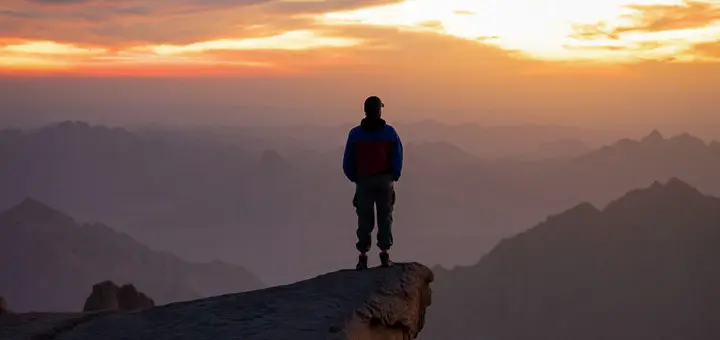
A hiker standing on one of Egypt Mountains at sunrise time. | © Sinai Hikes. Photo by Ahmed El Naggar
Before I ever stepped foot in the Egypt Mountains, I never imagined the country had landscapes that rise and breathe like these. For most, Egypt is about the Nile and golden sands, but out past the temples and tourist trails, the land tells another story. Mountains in Egypt, Sinai, the Red Sea Hills, the Western Desert, and all the way down to Nubia feel like places where the earth has paused to remember. Each region is its own world: in Sinai, the jagged granite and soft light at dawn feel ancient and sacred. Along the Red Sea, winding passes cut through stone that once directed gold caravans and Bedouin trails. Further south, mist hugs the green ridges of Mount Elba like the breath of a forest trying to survive the desert.
Egypt Mountains aren’t just natural. They’re personal You hear it in the silence, broken only by wind, camels, and the voices of animals. You see it in the careful paths made by barefoot children and the stories carried by their elders. Mountains in Egypt aren’t there to impress you. They’re there to invite you into something slower, older, and more real. At Sinai hikes and treks, we believe the best way to understand Egypt is to walk it. Not just the cities or the museums but the trails carved into mountains over centuries. If you’re looking for that kind of Egypt, this is where you’ll find it.
Are There Mountains in Egypt?
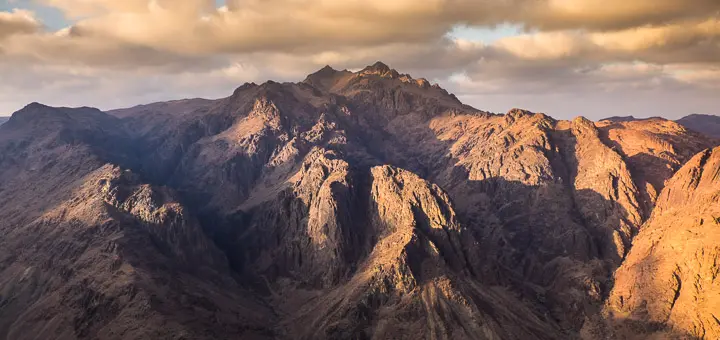
Mount Catherine as seen from the summit of Mount Sinai |Egypt Mountains | © Sinai Hikes.
When most people think of Egypt, they picture deserts, the Nile, maybe some temples and pyramids. That’s it. No one thinks about the mountains in Egypt. But here’s the thing: there’s a whole part of the country most folks don’t even talk about — the mountains. Yeah, the mountains in Egypt, not tiny hills either. We’re talking about serious elevation in places like Sinai, where the air gets cold and the sky feels closer. Mount Catherine is the highest point in Egypt, over 2,642 meters. People go up there for a day hike, silence, or just to say they stood on the roof of Egypt. Some go for religious reasons. Others just want to disconnect. Move east, and you get the Red Sea Mountains. They run long and rough, close to the coast. The land changes from less soft sand to more hard stone. You’d see ancient paths, sometimes even fossil beds. Traders used to cross here long before cars or borders. The nomads and the wind still know the way.
And way down south, something unexpected happens. Around Mount Elba, near the border with Sudan, it’s green. Actual green. Plants, shrubs, even trees in places. It catches fog from the coast, and somehow, against all odds, life holds on. People live near these mountains in real communities too. Bedouin tribes, southern families. They’re not just passing through; this is home. They know every curve of the terrain, which herbs grow where, which trail to take at sunrise, and which cave gives the best shade at noon. So yeah, mountains in Egypt. Maybe they’re not in the brochures, but they’re there—massive, silent, and full of stories. You just have to leave the main road and start listening.
What Percentage of Egypt Is Desert?
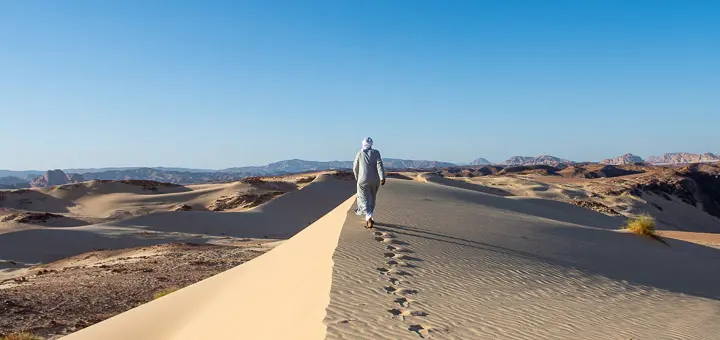
Bedouin man walking barefoot in the Sinai Desert. | Egypt Mountains & Deserts | © Sinai Hikes.
Egypt is mostly desert, over 90% of its land is officially classified as such, and while that number is technically accurate, it barely scratches the surface of what that really means. Most people imagine endless sand and sun, but Egypt’s desert isn’t just flat and empty—it’s full of contrast. There are towering cliffs in the Western Desert, weathered by time and wind. Strange rock formations that look like they belong on another planet. Fossil-rich plateaus. And, of course, mountains.
That’s the part people don’t expect mountains rising inside the desert. In places like the Red Sea Hills, rugged ridges stretch for hundreds of kilometers. In the far southeast, Mount Elba breaks the stereotype completely, capturing mist and supporting rare plant life in an otherwise dry zone. So yes, over 90% of Egypt is desert by land area. But much of that desert is alive, shaped by wind, time, and elevation. And the mountains in Egypt that grow out of these dry regions are often the reason life can still exist there, quietly defying what we think we know about deserts.
Egypt Mountains Range: Key Regions and Geography
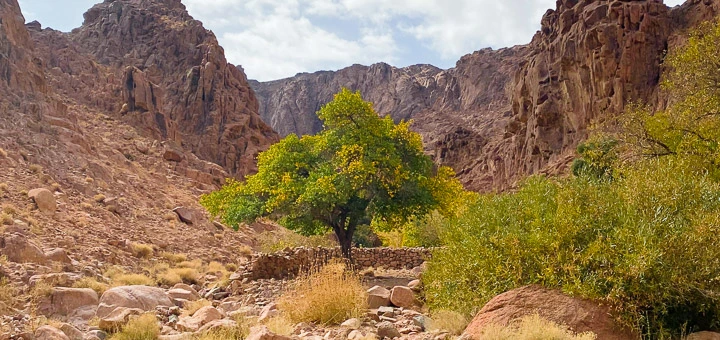
A green tree stands quietly in Wadi Gebal, Saint Catherine city | Egypt Mountains | © Sinai Hikes.
Egypt Mountains are not confined to one central range but are instead spread across distinct geographical regions. Each of these regions has its own geological character, climate, and cultural imprint. The diversity is striking, from snow-dusted peaks in Sinai in winter to volcanic cones in the Western Desert to green highlands in the deep south.
1. Mount Sinai (Jebel Musa)
- Altitude: 2285 meters (7497 feet).
- Location: Southern Sinai, Saint Catherine town.
- Significance: A sacred site in Judaism, Christianity, and Islam, deeply spiritual and historically iconic.
Why It Matters
Mount Sinai in Egypt isn’t just a mountain; it’s a meeting point of faiths. For centuries, people have believed this is where the Prophet Moses received the Ten Commandments. That belief alone has turned it into one of the most visited spiritual sites in Egypt. But even for those who aren’t religious, the mountain holds a quiet power. It’s not the height or the view; it’s the atmosphere. Something about the stillness, the stars above during the night hike, and the chill of dawn makes people stop and reflect.
The Climb
There are two main ways to reach the summit:
- Camel Trail: A wide, winding path that stretches for almost 5 km, about 4.15 km as a zigzag trail, followed by less than 1 km of rocky steps (750 steps in total). This route is easier on the knees compared to the steep alternatives. Camels are available for hire along the trail, but only up to the base of the 750 steps.
- Steps of Repentance: A much steeper route with about 3,750 steps, carved into the rock by monks. Harder, but unforgettable. “Closed now”
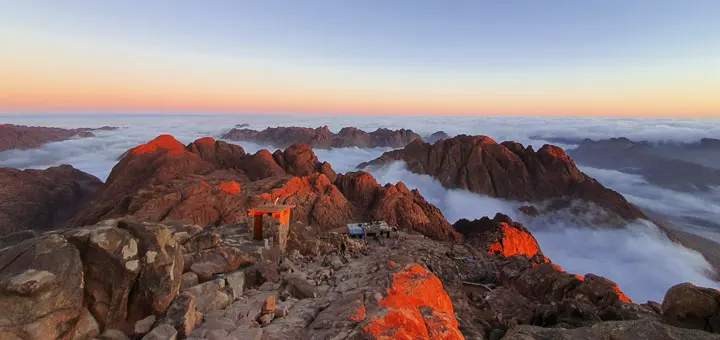
Above the clouds after sunrise on Mount Sinai | Egypt Mountains | © Sinai Hikes.
Both paths usually start just after midnight. Why? Because the goal is to reach the top before sunrise. And that moment when the first golden light hits the stone and silence fills the air feels sacred, no matter who you are. This is one of the most powerful experiences in the Egypt mountains. At the base of the mountain sits Saint Catherine’s Monastery, one of the oldest Christian monasteries in the world. It’s home to ancient manuscripts, icons, and what many believe to be the Burning Bush itself. The monks there live in simplicity and prayer, surrounded by centuries of tradition.
The Experience You don’t need to be religious to climb Mount Sinai. But if you do, don’t rush it. Walk slowly. Breathe. Talk to your Bedouin guide. Notice the candles some people carry. Listen to how quiet it gets near the summit. Most of all, take in the sunrise not with your phone, but with your eyes. It lasts only a few minutes, but it stays with you for years.
2. Mount Catherine (Gabal Katherina)
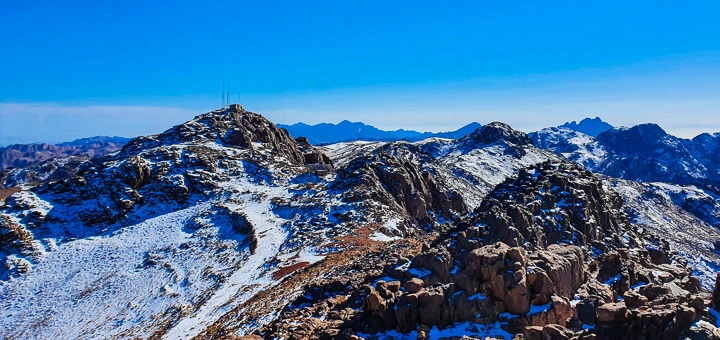
Snow dusts the summit of Mount Catherine (Gabal Katherina). | Egypt Mountains | © Sinai Hikes.
- Altitude: 2642 meters (8668 feet)
- Location: South-central Sinai, near the town of Saint Catherine
- Significance: Highest Egypt Mountains, spiritual, ecological, and cultural landmark
Overview:
Mount Catherine, also known as St Catherine Mountain, stands as Egypt’s highest natural point and one of the most spiritually charged locations in the Sinai Peninsula. The mountain is named after Saint Catherine of Alexandria, and for centuries it has drawn Christian pilgrims, Sufi seekers, hikers, and travelers searching for quiet and perspective.
3. Mount Serbal
- Altitude: 2070 meters (6791 feet)
- Location: Near Wadi Feiran, Western Sinai
- Significance: Some believed in ancient times that Mount Serbal was the true biblical Mount Sinai, and that it was a sacred place where Baal was worshipped.
Overview:
Less crowded than Mount Catherine or Mount Sinai, Mount Serbal is one of the hidden gems of the Egypt mountains, offers a challenge. Ancient Christian hermits once lived in caves along its slopes, and the area is dotted with inscriptions, ruins, and natural shelters.
Trekking Conditions:
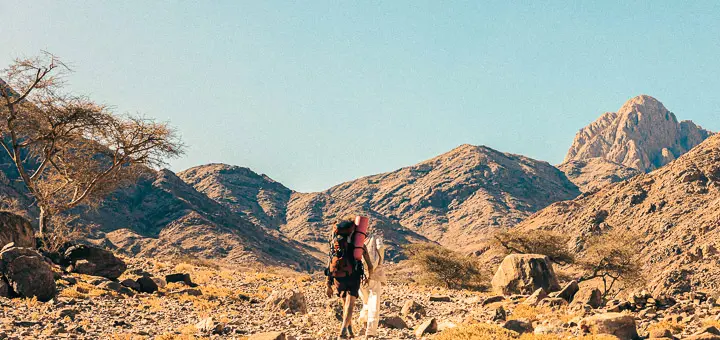
Hiker with a Bedouin guide on Mount Serbal trail, South Sinai. | Egypt Mountains | © Sinai Hikes.
- Difficulty: Challenging and wild trail.
- Accessibility: More remote, without tourist facilities, better for experienced hikers
- What to Expect: Silence, solitude, and a powerful sense of untouched history
- Cultural Note: While it lacks the infrastructure of other mountains in Sinai, Serbal’s raw and sacred atmosphere makes it a favorite among independent travelers and scholars.
4. Mount Abbas Basha
- Altitude: Approx. 2380 meters
- Location: Near Mount Catherine, Saint Catherine City, South Sinai
- Significance: Named after Abbas I of Egypt, who planned a palace on its summit
Historical Relevance
In the middle of the 18th century, Khedive Abbas I sought to build a palace here, believing the high-altitude air would improve his health. The construction was never completed, but remnants remain scattered of stones, platforms, and a surreal sense of abandoned ambition.
Hiking Experience:
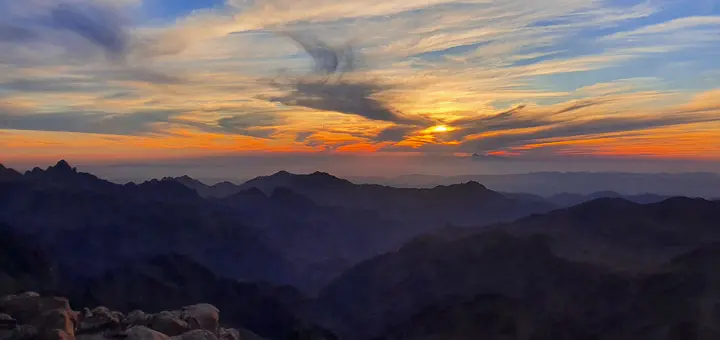
Sunset from Mount Abbas Basha in Sinai, Egypt Mountains | © Sinai Hikes
The ridges are wide and open, and as you walk along them, you get this breathtaking panoramic view over the town of Saint Catherine and Egypt mountains. It’s quiet, huge, and kind of humbling like the land is telling you to slow down and just take it all in.
- Often used as a base for further exploration
- Cooler temperatures, ideal for longer treks
Why Go?
It’s not one of those famous mountains and honestly, that’s kind of the charm. You don’t get crowds or big tour groups. What you do get is quiet… space to breathe. The kind of place where the air feels different and the ground tells old stories if you slow down enough to notice. If you’ve been on the usual trails and want something that feels untouched this might just be it.
Map of Egypt Mountains
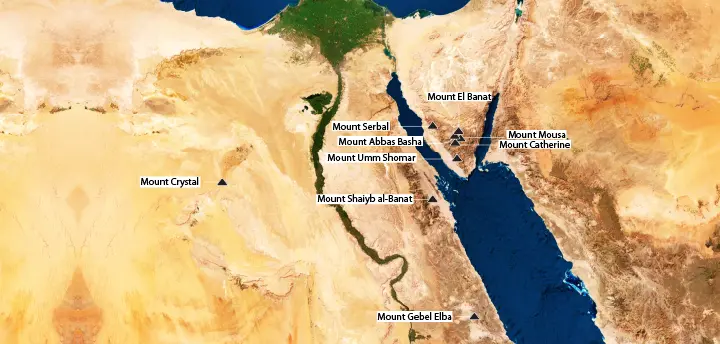
The 9 Most Iconic Mountains in Egypt | Egypt Mountains Map |© Sinai Hikes.
It’s hard to really understand Egypt’s mountain ranges until you see them on a map. Reading about them is one thing, but when you actually look at where they stretch, how they rise from deserts, and how far apart they are, it clicks. Maps do more than just show directions. They tell stories. You can see where ancient trails cut through the rocks, where Bedouin tribes settled, and where green valleys unexpectedly appear in the middle of dry land. Here’s a quick guide to the main mountain zones you’ll spot on a map:
- Sinai Peninsula: This is the heart of the Egypt Mountains, tight clusters of granite peaks like Mount Catherine, Jebel Musa, and Mount Umm Shomar. The area is full of footpaths, monasteries, and natural springs. It’s also one of the most mapped regions due to tourism and spiritual travel.
- Eastern Desert (Red Sea Range): These long mountains run down the Red Sea like a spine. They’re steep on one side and roll into the desert on the other. Maps here usually mark old mining routes, wadis, and rugged hiking trails.
- Southern Frontier (Halaib & Shalateen): The surprise zone Mount Elba stands out as green in a sea of sand. Maps here show fog zones, wild plant belts, and small tribal communities.
- Western Desert & Nubia: This area feels more forgotten, but it’s full of weird rock shapes, fossil beds, and volcanic ridges. Great for those who want to get off the grid. Few paths, but lots of possibilities.
Sometimes, the best way to reset your mind is to just… get away. Like really away. Imagine spending 5 to 7 days trekking across Egypt’s mountains heights in Trekking in Sinai: St. Catherine Trails. No signal. No noise. Just you, the rocks, the sky, and people who’ve lived here for generations, the Bedouins. You camp in quiet valleys, eat whatever’s cooked over fire, and sit around listening to stories that aren’t in any book. For a few days, you live the way their ancestors did, simple, slow, real. You wake up with the sun, sleep early, and forget about everything else. It’s not a luxury. It’s something deeper. Something your soul might be quietly asking for.
Egypt Mountains Bucket List: Top 9 Peaks to Explore
1. Mount Catherine
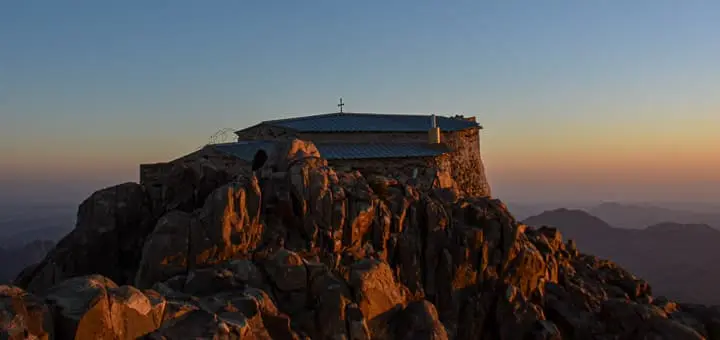
The Chapel of Mount Catherine, Sinai, Egypt | Egypt Mountains | © Sinai Hikes.
- Altitude: 2642 meters
- Address: Saint Catherine, South Sinai Highest Peak in Egypt
- Location: View Mount Catherine on Google Maps
There’s a moment when you’re standing at the summit of Mount Catherine, as one of the best of Egypt mountains and everything else—your phone, your plans, even your tired legs, just fades. It’s you, the wind, and a 360° view that doesn’t feel real. At 2,642 meters, this isn’t just Egypt’s highest peak. It’s a place that strips you down to your rawest self in the best way possible.
The first time I decided to climb Mount Catherine, I thought it would be just another hike. I’d done trails before. I had my boots, snacks, and a decent fitness level. But Mount Catherine is different. It doesn’t just test your body; it messes with your head, humbles your ego, and somehow, heals your spirit. The hike usually starts from the village of Saint Catherine. You walk through old footpaths used by Bedouins for generations. The air is dry but crisp, and there’s something ancient in the way the land looks at you. You pass rocks that feel like they’ve seen more than humans ever could. The sky here is impossibly wide, and the silence? It’s heavy but comforting.
About halfway up, the trail gets steeper, and the temperature starts to drop. You’ll feel it in your fingers, especially if you’re climbing at dawn or near sunset. But there’s a kind of rhythm that settles in when you stop checking your watch and start listening to your breath. Step by step, switchback after switchback, you slowly earn your way to the top. Once you reach the summit of Mount Catherine, there’s a small church, simple, silent, timeless. Built in the 1930s, it stands there like a whisper of prayer left behind by generations of climbers. Some people sit there for a while; others lie down on the rocks, eyes closed, letting the sun warm their faces. And then there’s the view.
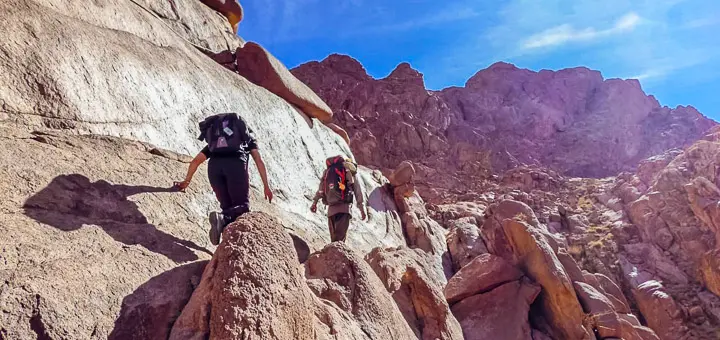
Ascent to Mount Catherine via Wadi Ahmar Trail. | Egypt Mountains | © Sinai Hikes.
The Climb: What to Expect
It’s not just beautiful; it’s overwhelming. You can see mountain after mountain, a sea of jagged peaks fading into soft desert haze. If you’re lucky, you might even see clouds sitting below you. That’s when it really hits you: you are standing on the highest point in Egypt. And not just physically—you feel high in every sense of the word, surrounded by the raw silence of Egypt mountains.
Mount Catherine isn’t flashy. It doesn’t beg for attention like Mount Sinai. But it’s quieter, more intimate. It demands effort, respect, and presence. And in return, it gives you clarity. I still remember drinking tea with the Bedouin guide after we came down. We didn’t say much; we didn’t need to. Some mountains speak loud. This one listens.
2. Mount Sinai (Gebel Musa)
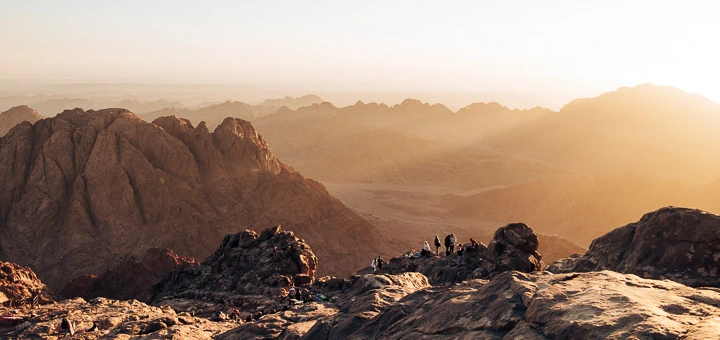
Sunrise over Mount Sinai in Saint Catherine | Egypt Mountains | © Sinai Hikes.
- Altitude: 2285 meters
- Address: Saint Catherine, South Sinai The Mountain of Revelation
- Location: View Mount Sinai on Google Maps
You don’t just climb Mount Sinai. You feel your way up. Step by step, breath by breath, heart first.
The Climb Begins in Darkness
There’s something in the air here different from all other Egypt mountains. Maybe it’s the altitude. Maybe it’s the weight of the stories that hang in the rocks. But from the moment you start the path of Mount Sinai, usually around 1 or 2 AM if you’re aiming to catch the sunrise, you know this isn’t just a hike. It’s a pilgrimage. The climb is long but manageable. Most people start in the dark, walking quietly under a ceiling of stars that don’t feel like the ones you see back in the city. It’s cold, sometimes really cold. You stop at tiny tea shacks along the way, where Bedouin men serve hot drinks and say little. They’ve seen thousands walk this path, yet each person looks like they’re seeing it for the first time.
There are two main routes up the mountain: the Camel Path then 750 steps, which is longer but more gradual, and the Steps of Repentance, a steep staircase of over 3750 steps carved into rock by monks centuries ago but it’s “closed now” . I took a mix of both. The camel path to pace myself, then the 750 steps to feel the history under my feet. As you get closer to the summit, you start to hear less around you. No footsteps, no chatter, just the sound of your breath and maybe your thoughts. And when you finally reach the top, cold, tired, and a bit shaky, you find something waiting for you in silence.
Sunrise from the Summit of Mount Sinai
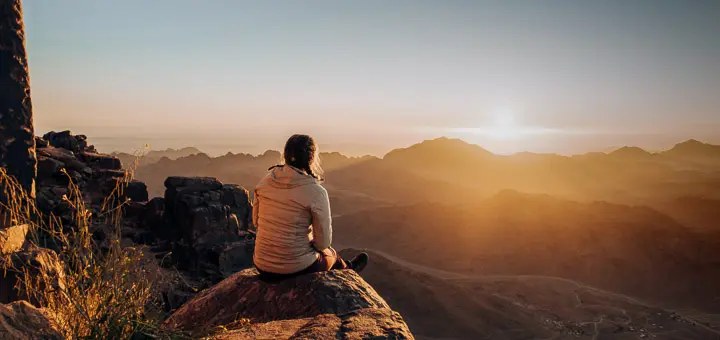
A sunrise moment with a friend up Mount Sinai | Egypt Mountains | © Sinai Hikes.
At the summit of Mount Sinai, there’s a small chapel built over the site where, tradition says, Moses received the Ten Commandments. And small mosques, whether you believe in that or not, the energy up there is undeniable. People sit quietly. Some pray. Some cry. Some just stare at the sky changing colors, from deep purple to flaming orange, as the sun rises slowly over the desert horizon, a sacred moment shared in the heart of the Egypt mountains.
And when that sun finally shows its face, everything goes still. It’s warm and golden and soft. It touches your face like a whisper. That moment? That’s why people come. That’s why they walk in the dark for hours. For that one minute of perfect stillness when heaven and earth feel close enough to touch. Climbing Mount Sinai isn’t about religion. It’s about stillness. Reflection. Wonder. It’s not a mountain you conquer, it’s a mountain that welcomes you in. And if you let it, it leaves something inside you you didn’t know you needed.
3. Mount Umm Shomar
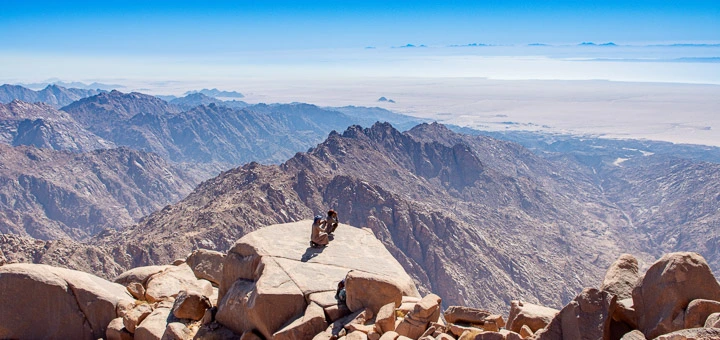
Two Bedouins pause above the world — Mount Umm Shomar | Egypt Mountains | © Sinai Hikes.
- Altitude: 2578 meters
- Address: South Sinai, The Wild Sister of Mount Catherine
- Location: View Mount Umm Shomar on Google Maps
There are some mountains that you plan to hike… and some that you stumble into. For me, Trekking in Egypt’s Ancient Nomad Trails for 10 days to Mount Umm Shomar and through the surrounding Egypt mountains was the second kind. I hadn’t heard much about it—no Instagram posts, no blog articles. Just a quiet mention from a Bedouin in the Saint Catherine area: “If you want real silence, go to Umm Shomar.” And so I went. This mountain doesn’t give you a warm welcome. It’s raw, steep, and… honest. The trail isn’t well-marked. You don’t see other hikers. You don’t hear much except wind whistling past dry granite and the crunch of your own boots. It’s remote, even for Sinai standards. And that’s what makes it so special.
A Mountain Few Dare to Climb
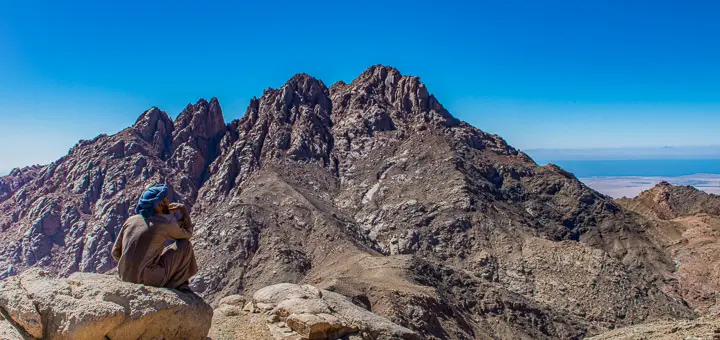
A Bedouin guide looking toward Mount Umm Shomar | Egypt Mountains | © Sinai Hikes
Umm Shomar rises to 2,578 meters, making it the second-highest mountain in Egypt after Mount Catherine. But unlike Catherine, there’s no trail of tea huts, no guides waiting around. You have to arrange it with local Bedouins, and even then, most of them raise an eyebrow and ask, “Are you sure?” The hike is hard. Not in a brutal way, but in a quiet, draining way. You walk for hours through rocky valleys, scramble up steep slopes, sometimes using your hands to steady yourself. No shade. No distractions. Just you and the mountain. Every break feels well-earned, and every sip of water feels like a gift.
The View That Changes Everything
About halfway through, I started questioning why I was doing this. My legs ached. The sun felt closer than the sky. But then you reach the high ridge, and suddenly, it all makes sense. The view opens up like a story you didn’t expect, a vast, rugged expanse of Egypt’s mountains. You see endless waves of peaks, Saint Catherine, Serbal, and even hints of the Red Sea in the far distance if the day is clear. You feel like you’re walking on the bones of the earth.
At the summit of Mount Umm Shomar, there’s nothing man-made. No cross. No sign. No stone shelter. Just sharp silence and rocks bleached by sun and time. I stood there alone, no one else in sight. And it felt like the mountain was watching me back, not judging, not welcoming, just noticing. I didn’t cry. I didn’t pray. But something shifted. Maybe it was pride, maybe it was peace. Maybe it was just quiet, real quiet, the kind you never find in the city. That’s what Umm Shomar gave me. It’s not a mountain for everyone like most of Egypt mountains. But if you’re searching for something stripped of ceremony, stripped of comfort, but full of meaning, then this is your trail. Just make sure you leave your ego at the base. You won’t need it at the top.
4. Mount Abbas Basha
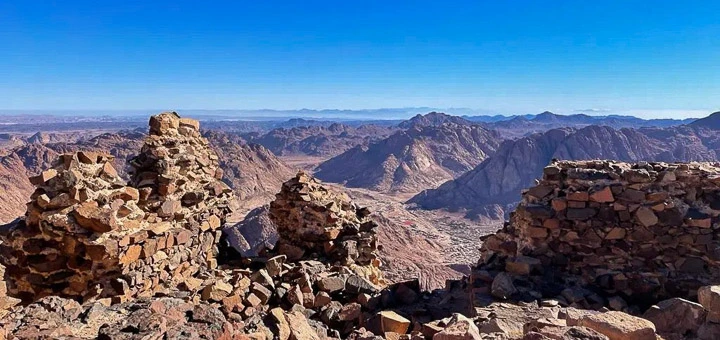
Ruins of a forgotten dream of Mount Abbas Basha | Egypt Mountains | © Sinai Hikes.
- Altitude: 2383 meters
- Address: Saint Catherine city, The Forgotten Ambition in the Heart of the Egypt Mountains
- Location: View Mount Abbas Basha on Google Maps
When people talk about Egypt’s mountains, they usually mention Mount Sinai or Mount Catherine. But tucked quietly nearby lies a mountain with a story so human, so bittersweet, that you can’t help but feel it under your skin as you climb.
Mount Abbas Basha in Saint Catherine, Egypt isn’t just another peak; it’s a monument to an unfinished dream. In the mid-1800s, Abbas I of Egypt, grandson of Muhammad Ali, was seriously ill. Doctors told him the pure air of South Sinai might help his health. So, what did he do? He ordered the construction of a palace, yes, a palace right at the summit of this remote mountain. Stone by stone, men carried materials up the harsh slopes. They were built for years. Then Abbas died… and the project was abandoned.
The Forgotten Palace at the Summit
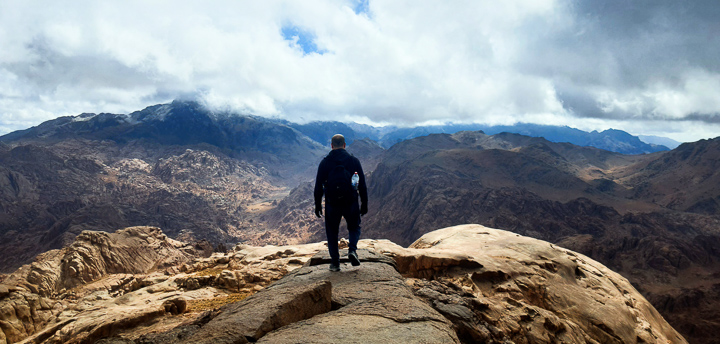
Hiker descending from Mount Abbas Basha via Abo Mahashor Trail | Egypt Mountains | © Sinai Hikes
Today, the ruins of that never-finished palace still sit near the top. Silent. Weathered. Forgotten by most. And that silence? It speaks louder than any words. Climbing Mount Abbas Basha isn’t just about the altitude; it’s about following a path of ambition and decay. The route starts close to the trail to Mount Catherine but quickly veers off into a more isolated track. It’s not as difficult as Mount Catherine, but it has its own kind of weight. You pass through high plateaus and rocky corridors, and the higher you get, the quieter the world becomes. This is the Egypt mountains at their most introspective, silent, weathered, and vast.
The mountain has a different energy. It’s not exactly sacred like Mount Sinai. Not wild like Umm Shomar. It feels… abandoned. But not in a sad way. In a humbling way. Like you’re visiting a story left open on purpose. Reaching the summit, you see the remnants of the palace, a few broken walls, outlines of rooms, and stones that were meant to be more. The view stretches endlessly, but your eyes keep coming back to those ruins. You wonder what it would’ve looked like if Abbas had lived longer. Would there be domes and gardens here? Would people have sipped tea above the clouds?
But maybe the beauty of Mount Abbas Basha is in the fact that it remains unfinished. A reminder that not all big dreams reach completion, and that’s okay. There’s a strange comfort in that. I sat near one of the crumbled walls for a long time. Not thinking, just breathing. And in that moment, I realized some places don’t give you answers; they just let you rest your questions for a while.
5. Mount El Banat
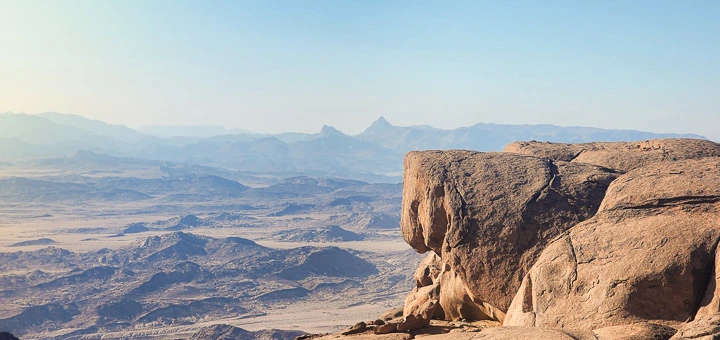
Peaceful horizons — from the summit of Mount El Banat in South Sinai. | Egypt Mountains | © Sinai Hikes.
- Altitude: 1980 meters
- Address: Saint Catherine city, South Sinai The Mountain of Stillness and Story
- Location: View Mount El Banat on Google Maps
Some names carry a kind of softness. “Mount El Banat” the Mountain of the Girls, sounds like something out of a fairytale. But the climb? It’s real. And it’s raw. Tucked away in the deeper parts of South Sinai, Gebel El Banat stands quietly at 1,980 meters. It’s not as high as Mount Catherine, and it doesn’t shout for attention like Gebel Musa. But once you’re there, standing among its gentle slopes and wide-open views, you realize this mountain doesn’t need to be loud. It simply is. I heard about it from a local guide who said, “It’s the most peaceful mountain I’ve ever walked.” That was enough for me. Among the Egypt mountains, El Banat holds a kind of peace that doesn’t demand attention, it just offers it.
The trail of Mount El Banat isn’t crowded. In fact, you’ll probably have it all to yourself. The climb starts from lower wadis and moves through soft curves in the land, less rugged than other peaks but still wild in its own way. You pass through valleys with little vegetation, some fig trees, thorny bushes, and the occasional goat skull reminding you who lives here and who just visits.
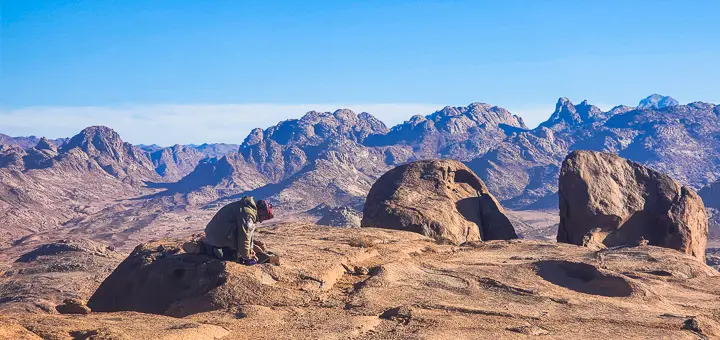
Bedouin guide collecting wood on Mount El Banat in Sinai | Egypt Mountains | © Sinai Hikes.
A Trail of Silence and Legends
There’s no official history behind the name “El Banat,” but some locals say it refers to old legends about a group of girls who fled to the mountains seeking freedom, solitude, or escape from something we’ll never know. Others say it’s just a poetic name chosen for the shape of the peaks, graceful and open like arms stretched to the sky. What struck me most wasn’t the view; it was the quiet. Not silence, exactly, but the kind of calm that feels built into the land. The rocks don’t echo. The wind doesn’t whistle. Everything here moves slowly, gently. It’s the kind of place where you can walk for hours without checking the time once.
When I reached the top of Mount El Banat, I didn’t rush to take photos. I just sat. There was no structure, no marking, and no summit flag. Just rock and sky and the warm feeling that I didn’t need to go any higher. Mount El Banat isn’t a challenge for the body; it’s a gift to the soul. If you’re tired of chasing peaks for likes or bragging rights, come here. This mountain doesn’t care who you are. But if you sit with it long enough, it might just remind you.
6. Mount Serbal
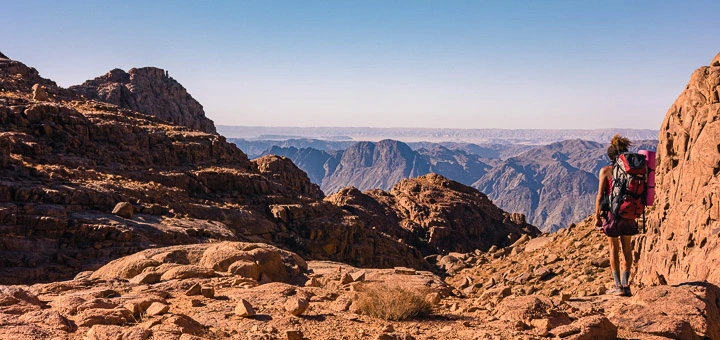
Tracing ancient paths with a hiker climbs Mount Serbal | Egypt Mountains | © Sinai Hikes.
- Altitude: 2070 meters
- Address: Saint Catherine city, Wadi Feiran, South Sinai The Eastern Desert’s Silent Giant
- Location: View Mount Serbal on Google Maps
When I first heard about Mount Serbal, it wasn’t from a travel blog or a guidebook. It was from a Bedouin guy in Wadi Feiran who pointed to the horizon and said, “That mountain… it’s different.” And he was right. Serbal isn’t just a mountain you climb; it’s a place that makes you feel like you’re stepping into something ancient. You don’t see signposts or paved trails here. What you see are jagged granite ridges that look untouched, like they’ve been standing there quietly for thousands of years, watching people come and go.
The hike itself isn’t easy. It’s a hard hike. Dry and hot, sometimes the path disappears, and you have to guess your way forward, trusting the rhythm of the rocks and your own breath. But that’s part of what makes it special. You’re not just walking; you’re connecting. With nature, with yourself, and maybe even with something bigger. What makes Serbal stand out isn’t just the view (though it’s amazing), but the feeling. As you move higher, the noise in your head gets quieter. And then suddenly, you’re standing still, staring at the valley below, and everything makes sense for a minute.
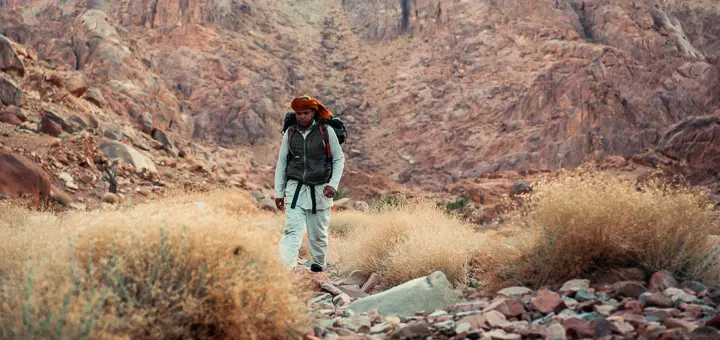
Bedouin guide trekking through Sinai valleys toward Mount Serbal | Egypt Mountains | © Sinai Hikes.
Where Legends Still Whisper
People around here believe this mountain was sacred long before any organized religion. Some say it’s the real Mount Sinai. Others say it was a place where monks lived and prayed in isolation. And when you walk around these mountains in Egypt and see old ruins, stones that look like they were once rooms or shelters, you can almost imagine someone sitting there in silence, centuries ago, listening to the wind the same way you are. The name “Serbal” is believed to come from “Sarb Baal,” meaning “the palm grove of Baal,” an ancient god once worshipped in the area. Whether you believe that or not, it adds a layer of meaning that sticks with you.
Climbing Mount Serbal isn’t about reaching the top. It’s about the quiet in between. The break you take halfway up. The shade you find under a boulder. The way the sunset hits the rocks just before dusk. It’s not a hike you do for Instagram and social media. It’s one you do for yourself. And honestly? I’d go back in a heartbeat.
7. Mount Shayib El Banat
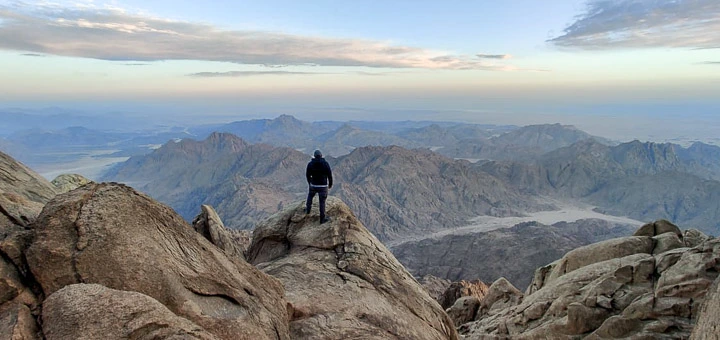
Above it all, a lone hiker stands on Mount Shayib El Banat| Egypt Mountains | © Ayman Hassan.
- Altitude: 2187 meters
- Address: Red Sea, Eastern Desert, near Safaga The Eastern Desert’s Silent Giant
- Location: View Mount Shayib El Banat on Google Maps
If Sinai is a story of sacredness and scripture, then the Eastern Desert is poetry written in silence. And standing tall among its rolling, burnt-orange ranges is the little-known but deeply majestic Mount Shayib El Banat — the highest peak in Egypt’s Eastern Desert. At 2,187 meters, it’s not Egypt’s tallest, but it carries a different kind of presence. This mountain feels ancient. Not just old in years, but in spirit. Like it’s been watching the Red Sea from a distance for lifetimes.
Egypt’s Forgotten Mountain of Mystery and Solitude
The journey to Mount Shayib El Banat is half the experience. It starts near Safaga, on dusty, empty roads that cut through nothingness. You drive for what feels like forever, passing through wadis that look like they’ve never seen rain. And just when you start to wonder if the mountain is even real, there it is. Rising bold and dark against the soft desert sky. There are no tourist signs. No checkpoints. No trails marked on apps. This is the kind of hike you do with someone who knows the land — or not at all. Among the Egypt mountains, Shayib El Banat remains one of the most remote and least marked, untouched by signs or modern trails. The climb itself is a mix of open plains and steep, rocky faces. Parts feel like walking on the moon. The heat can be intense, but if you’re lucky and start early, you’ll catch the morning shade clinging to the east slopes.
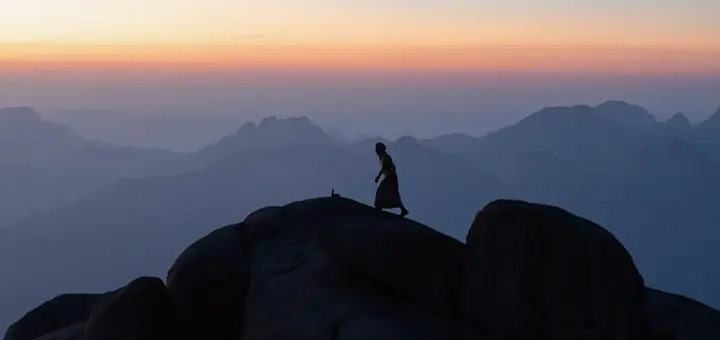
Bedouin guide up Mount Shayib El Banat | Egypt Mountains | © Photo by Ahmed El Naggar.
They say the name “Shayib El Banat” loosely means “the old man of the girls,” a name that hints at folklore, but no one seems to know the full story. And honestly, the mystery adds to the magic. This isn’t a mountain of facts. It’s a mountain of feeling. What I remember most is the sound of nothing. Total stillness. Even the wind was soft, like it respected the mountain too much to speak loudly. Every step upward felt like walking inside a secret.
At the summit, there’s no monument. Just space. Endless, bright, burning space. The Red Sea glimmers far to the east, and behind you, the desert stretches like a story without punctuation. You don’t feel high; you feel small. And free. Mount Shayib El Banat isn’t for casual hikers. It’s remote, unmarked, and utterly wild. But if you’re looking for the kind of silence that rearranges you from the inside out, this is your place. I left a stone at the top. No message. Just a small sign that I’d been there, that I listened. And the mountain? It stayed quiet. Like it was smiling.
8. Mount Elba
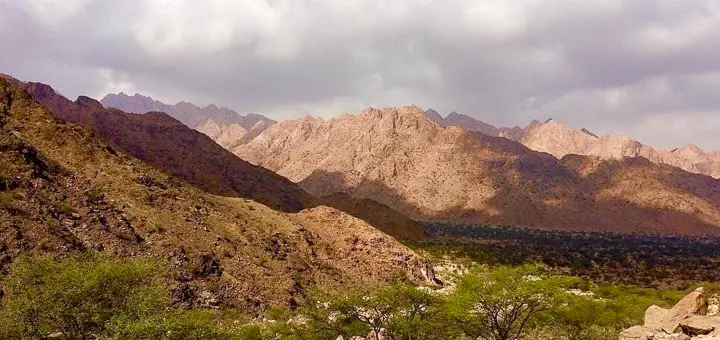
Mount Elba the Egypt’s hidden green mountain, | Egypt Mountains | © Photo by @Marwan Magdi.
- Altitude: 1435 meters
- Address: Halaib Triangle, Red Sea Governorate Egypt’s Misty, Hidden Rainforest
- Location: View Mount Elba on Google Maps
It’s hard to believe, but somewhere on the far southern edge of Egypt, tucked inside the Halaib Triangle near the Sudanese border, lies a mountain that almost feels like it doesn’t belong to this world Mount Elba. Forget what you think you know about Egypt. Mount Elba is green. Really green. We’re talking cloud forests, wild fig trees, acacia groves, and mist hanging in the air like something out of a dream. And the best part? Almost nobody knows it’s there.
Egypt’s Green Secret: Where the Desert Turns to Forest
Rising to 1,435 meters, Mount Elba isn’t the tallest mountain in Egypt. But it’s absolutely one of the most unique. Thanks to a rare microclimate created by moist Red Sea air getting trapped against its slopes, this mountain gets regular fog and rainfall, enough to support lush vegetation, rare wildlife, and even species you won’t find anywhere else in the country. Getting there isn’t easy. In fact, unless you’re part of a scientific expedition or have special permissions, Mount Elba is off-limits to casual travelers. It lies inside a protected area that’s managed for both security and conservation. That alone adds to the mystery: a rainforest in Egypt that most Egyptians have never seen. But let’s imagine you could go.
The climb wouldn’t be about elevation gain; it would be about immersion. You’d hike through green valleys instead of dry wadis and hear the chirping of birds instead of the whistling of wind. Butterflies. Monkeys. Maybe even a leopard if you believe the legends. Every few meters the landscape would change. It’s like hiking through ten ecosystems at once. And then there’s the fog. Sometimes the summit isn’t even visible. It floats in a sea of white mist, only appearing for a moment before disappearing again. Locals call it the mountain that drinks from the sky. Romantic? Yes. True? Definitely.
To stand at the top of Mount Elba would be to stand in a part of Egypt that doesn’t make it to the postcards. Not pharaohs. Not deserts. Just wild, untouched nature, soft, green, and ancient in a totally different way. Mount Elba is Egypt’s quietest miracle. And if the earth has lungs, this is where it breathes.
9. Crystal Mountain
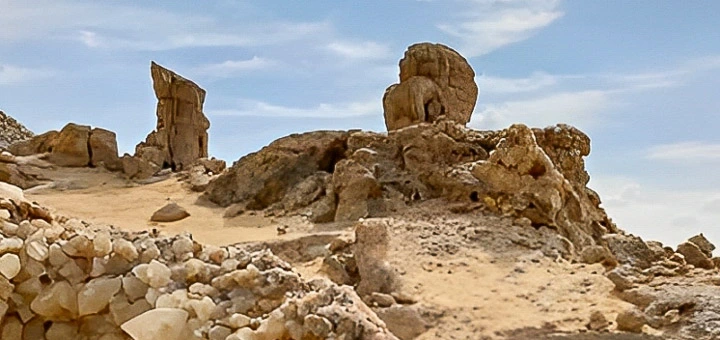
Crystal Mountain | Egypt Mountains | © Photo @ixelsdreamspace.
- Altitude: ~350 meters
- Address: Western Desert, near Bahariya Oasis Western Desert, near Bahariya Oasis
- Location: View Crystal Mountain on Google Maps
The first time I heard about Crystal Mountain, I thought it was just another tourist stop in the desert, maybe a nice photo opportunity, and that’s it. But what I saw when I actually got there far away from most of Egypt’s high mountains felt like stepping into a different world entirely. No exaggeration. It’s one of those places you think might disappoint, and then suddenly you’re standing in front of it… completely still.
The Desert’s Hidden Gem
It’s not really a “mountain” if we’re being technical. It’s more like a shiny hill that appears out of nowhere in the middle of endless sand. But what makes it incredible is that it’s made of pure crystal and quartz embedded in stone. The sunlight hits it just right, and everything lights up. The rocks sparkle like someone dropped diamonds all over the place. I remember just looking down at my feet and seeing little reflections everywhere. I didn’t even want to move; I was afraid I’d break something beautiful.
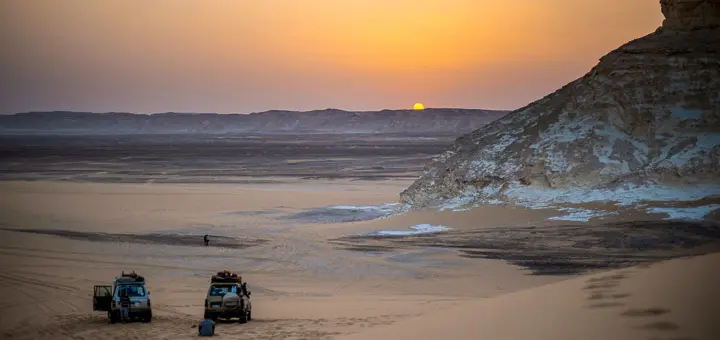
Sunset over the Bahariya Oasis | Western & Eastern Deserts of Egypt | © Amira Shawky via Unsplash.
The atmosphere around the site is something else too. No fences, no crowds, not even a path, really. You just stop the car, get out, and walk straight into this strange, glowing patch of land. And it’s silent, like, properly silent. No noise except maybe a light breeze. It felt weirdly calm, like the mountain was asking you to lower your voice. There’s no information sign or guide explaining how it got there, and I liked that. It made the experience feel more raw. Some locals say the crystals were exposed by erosion or maybe a blast during road construction nearby. Whatever the reason, the result is surreal.
I picked up a small piece of crystal and turned it in my hand. It was warm from the sun and smooth like glass. I didn’t take it with me. Something about the place made me feel like I shouldn’t. It belonged there. Crystal Mountain is not about the climb, the views, or the Instagram shots. It’s about the moment when you stand there, realize how strange and beautiful nature can be, and feel lucky you got to see it up close.
Why a 5–7 Day Hike in Egypt Mountains Might Be the Best Gift You Give Yourself
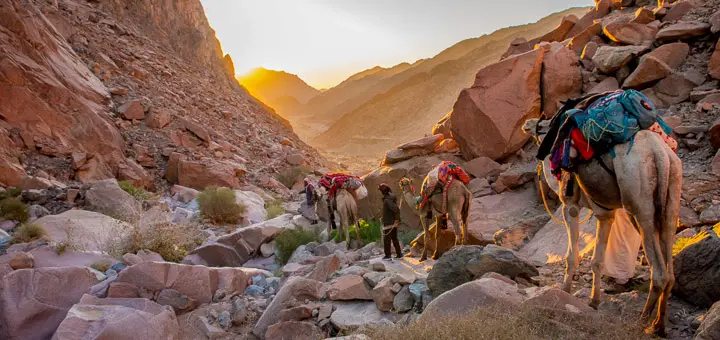
Camels descend Sinai Mountains toward Wadi El-Kid. | Egypt Mountains | © Sinai Hikes.
Sometimes, the best thing you can do is just pause… and go somewhere completely different. And honestly, deciding to spend 5 to 7 days exploring Egypt’s mountains might be one of the most rewarding choices you’ll ever make. It’s not about climbing the highest peaks just to say you did. It’s about what happens in between the early morning light in Saint Catherine, the silence on top of Mount Catherine, the way the stars look at night when there’s no one else around. It’s how each mountain gives you a different feeling, a different lesson, a different kind of peace.
Spending a week walking through Egypt’s highland trails resets your head and your heart, you disconnect from noise, pressure, and screens, and reconnect with your own rhythm. You wake up with the sun, move with your breath, and fall asleep under open skies that don’t need filters. At Hiking in Egypt’s highland trails, we believe these aren’t just trips; they’re transformations. That’s why we help you plan them the right way: safe, soulful, and unforgettable. So if you’ve been searching for a real break, not just time off, this is it. Pack light, walk slowly, and let the mountains do the rest.
The Highest Mountain in Egypt: Mount Catherine
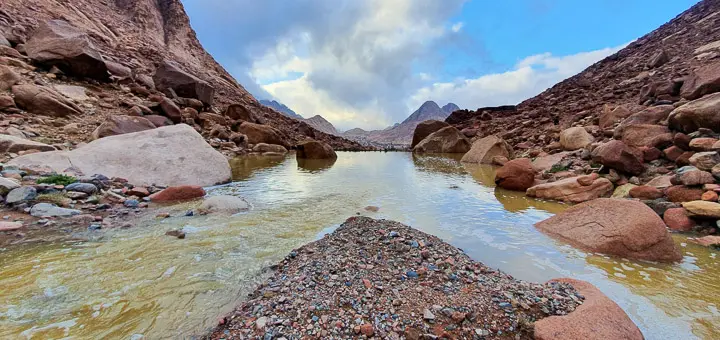
Flash-flood aftermath on the Mount Catherine trail | Egypt Mountains | © Sinai Hikes.
You don’t have to be a professional climber to feel the power of Mount Catherine. At 2,629 meters, it’s the highest point in all of Egypt, but its height isn’t what stays with people. It’s the feeling you get when you stand at the top and realize how quiet the world can be. Tucked away in southern Sinai, not far from the small town of Saint Catherine, the Egypt Mountains have been a destination for all kinds of travelers: pilgrims, hikers, and solitude-seekers. Some come for the sunrise. Some come for the silence. Some come because they heard it changes you, and it often does.
You’ll need a few hours to reach the summit of the highest mountain in Egypt, guided by local Bedouins who know every bend in the trail. They’ll show you where monks carved their prayers into stone and where rare herbs still grow between cracks in the rock. And once you’re up there? The view is endless. It’s wind and sky and shadow. You see other mountains, valleys, and maybe even Saudi Arabia if the day’s clear. But what you feel is more important: a pure stillness, like the mountain is holding its breath just for you. Mount Catherine is more than Egypt’s tallest peak. It’s its quietest voice. Before you plan your climb, don’t miss our Hiking Safety Tips: Your Ultimate Guide to Staying Safe in Sinai, essential for anyone heading into the highlands.
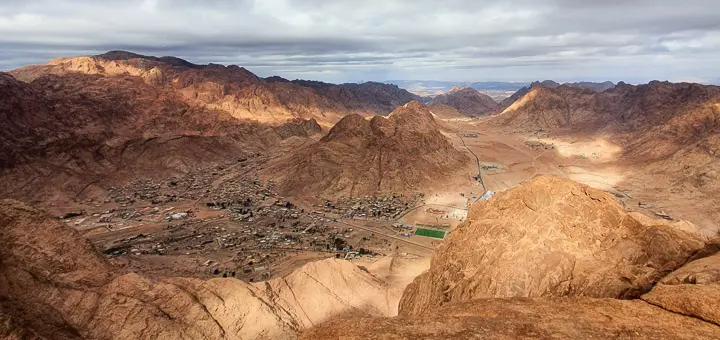
View of Saint Catherine town from a high summit near Mount Catherine. | Egypt Mountains | © Sinai Hikes.
Egypt Crystal Mountain: A Natural Wonder
The first time you see Crystal Mountain, you might not believe it’s real. You’re driving across the Western Desert between Bahariya and Farafra, and everything looks the same for hours: flat, dry, and yellow. Then suddenly, something glitters ahead. You get closer and realize it’s not glass, not metal, not man-made. It’s a hill covered in natural crystal. That’s when you realize: you’ve found it So, what exactly is it?
- Crystal Mountain isn’t really a mountain. It’s more like a rocky ridge, small in size but massive in impact. What makes it unique is the huge concentration of calcite and quartz crystals embedded right into the rock face. These minerals formed millions of years ago, during a time when hot, mineral-rich water moved through the limestone underground. When the desert cooled and pressures shifted, the minerals crystallized, and what’s left is a glittering hill that looks like it belongs on another planet.
- What It Feels Like to Be There There’s a strange silence when you stand near Crystal Mountain. It’s not just the usual desert quiet; it’s like even the wind slows down to let the crystals shine. The ground around it is rough and full of scattered shards that sparkle when the sun hits them. No matter how many pictures you’ve seen online, it feels completely different in person.
- A lot of people stop there on desert safaris. It’s one of those unplanned, 15-minute breaks that turns into an hour because no one wants to leave. Some eat lunch. Some just walk around in circles, amazed by how the Earth made something so fragile and strange, right there in the open.
- Why It Matters Crystal Mountain might not be as famous as the Great Pyramids or the Red Sea resorts, but it’s part of the quiet beauty of the Egypt mountains. It tells a story of deep time, of geology, pressure, temperature, and minerals all working together, long before humans ever got there.
- It’s also a story about responsibility. Sadly, some visitors take pieces of crystal with them. Over time, this has caused real damage to the fork formation. So if you go? Take pictures. Not pieces. That way, the next person who visits can feel the same sense of awe you did.
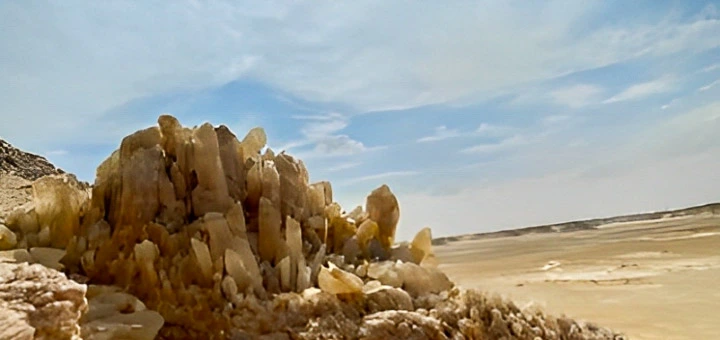
Magical crystal ridge in Egypt’s Western Desert | Egypt Mountains | © Photo @ixelsdreamspace.
How to Visit
- Location: Between Bahariya and Farafra oases (Western Desert)
- Access: Only reachable by 4×4 or guided safari part of most White Desert tours
- Best time to visit: Early morning or just before sunset (light hits differently)
- What to bring: Sunglasses, water, and a camera the reflections can be intense
You don’t have to climb it. You don’t even need to spend long there.
But if you ever find yourself standing in front of Crystal Mountain, give it a minute. Just one quiet minute. You’ll hear nothing but the wind, and you’ll feel how much wonder the desert still hides. While Crystal Mountain offers a surreal glimpse into Egypt’s geological wonder, the history of Egypt’s mountains runs far deeper, etched into every cliff, canyon, and ancient tomb.
Ancient Egypt Mountains and Their Historical Significance
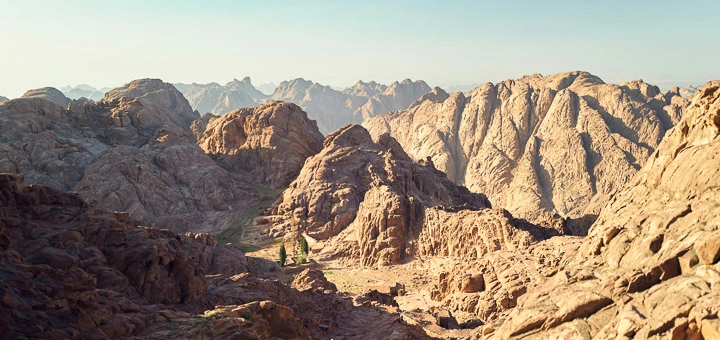
Prophet Elijah Basin from Mount Sinai | Egypt Mountains | © Sinai Hikes.
To know more about the ancient Egypt mountains we need to know that before maps or modern tools, mountains in ancient Egypt served many purposes, not just as part of the scenery but as part of life itself. People built around them, prayed toward them, and carved into them. These peaks helped define where people lived, how they moved, and what they believed.
Theban Cliffs and the Valley of the Kings
If you ever visit Luxor in southern Egypt, look behind the ancient city ruins, and you’ll see a row of cliffs standing quietly in the background. That’s where the mountains begin. The pharaohs didn’t just choose the area for its beauty. They believed the west, where the sun sets, was linked to death and rebirth. So they built their tombs there, in the Valley of the Kings, carving directly into the mountain rock. It felt safer, more hidden, and somehow closer to the next life. The rock itself helped preserve everything – paintings, coffins, even writing. But more than that, the mountain acted like a silent guardian. Being buried there wasn’t just about protection. It was about respect. You weren’t just placed in the ground; you were placed in the landscape.
Mountains as Workplaces: Mining in the Eastern Desert
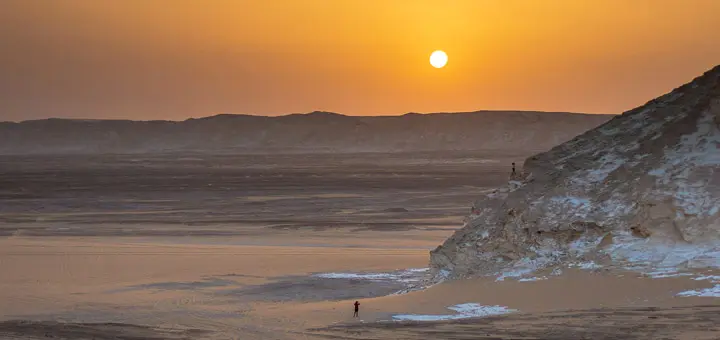
Sunset over the Bahariya Oasis | Western & Eastern Deserts of Egypt | © Amira Shawky via Unsplash.
In the east, where the Nile gives way to endless desert, mountains became something else entirely resources. The Eastern Desert was rich in stone and minerals. Pharaohs sent organized teams to places like Wadi Hammamat, where workers extracted gold, granite, and amethyst. What’s fascinating is that these workers didn’t just leave with materials; they left their mark. Literally. On the rock walls, you’ll still find inscriptions, names, dates, prayers for safety, and even short records of the mission. These are some of the oldest industrial notes known to history. So these mountains weren’t sacred in the same way as Thebes or Sinai. But they were essential. They built the temples, statues, and tools that kept Egypt going.
Sinai Mountains in Egypt: Climbing Toward the Divine
In Sinai, mountains meant something deeper. People didn’t just walk through Sinai mountains in Egypt; they climbed them to get closer to the divine. Sinai Mountain (also known as Mount Sinai or Jebel Musa) is believed by many to be the place where Moses received the Ten Commandments. But long before and long after that story, the act of climbing high places was tied to faith. Pilgrims, prophets, and seekers saw mountain peaks as quiet places to hear or be heard. Even today, people climb before dawn to reach the summit of Sinai Mountain and watch the sun rise in silence. The idea was simple: the higher you go, the closer you are to the sky. And maybe to something greater than yourself.
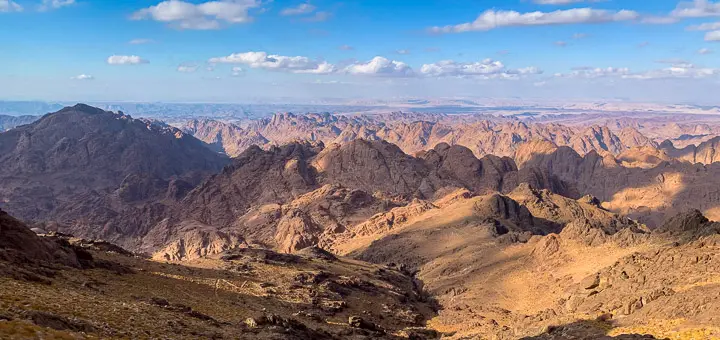
A magical view with the clouds for Sinai Mountains | Egypt Mountains | © Sinai Hikes.
Southern Mountains in Egypt: Borders, Shrines, and Rock Art
In Nubia and Egypt’s southern regions, mountains marked the edges of the known world. Some acted as natural borders between tribes. Others served as military outposts or locations for small, local shrines. But what stands out today is the rock art. On the faces of cliffs, early artists long before hieroglyphs carved scenes of animals, hunting, music, and ritual. These images show that the mountains weren’t just passed through; they were part of daily life and culture. Some mountains even had roles in trade, where caravans stopped to rest and worship. Others were simply there quiet, massive, and respected.
The ancient Egyptians didn’t ignore the mountains. They used them. They climbed them. They carved into them. They saw them not just as land, but as symbols of power, mystery, and the space between life and the afterlife. In every direction – west, east, south, and Sinai -the Egypt Mountains shaped the people as much as the people shaped the land.
Egyptian Mountains: Cultural and Ecological Importance
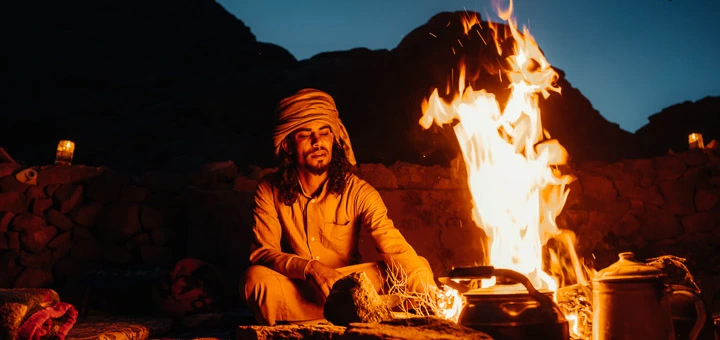
A Sinai Hikes guide prepares tea the traditional Bedouin way | Egypt Mountains | © Sinai Hikes.
When people think about Egyptian mountains , the first thing that might come to mind is just rock and sand. But for those who’ve lived near them, walked their paths, or even just spent a few quiet hours on one of their slopes, these mountains mean something very different. They’re not just part of the landscape. They’re part of people’s daily life, their identity, their survival, and their memories.
How People Live with the Mountains in Egypt
In Sinai, there are entire communities that have lived among the mountains for generations. The Jebeliya, Awlad Said, and other Bedouin tribes aren’t just residents; they’re experts of this land. They don’t use maps. They use memory. Among the mountains in Egypt, Sinai holds communities that have lived with the land for generations.
They know which mountain holds water after rain, where herbs grow in shady cracks, and which path is safest during a sandstorm. They treat the mountain like a relative with respect, caution, and sometimes even prayer.
Their oral stories and poetry often mention mountains by name. They describe peaks as guardians, places of silence, or even as witnesses to family histories. And when you walk with them, they point out rocks or trees with stories. “My grandfather rested here. This spring saved a man during a drought. This cliff echoed a wedding song.”
In the South: Culture in the Hills
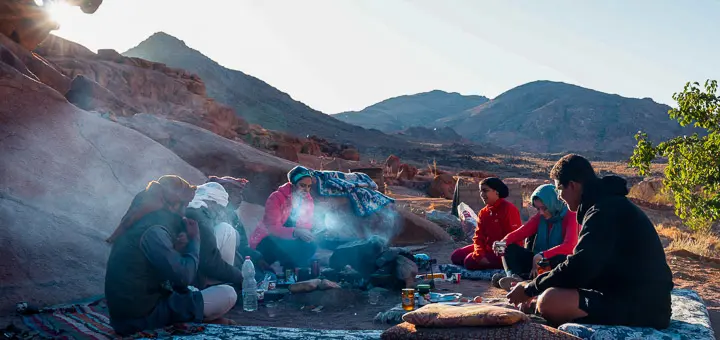
Morning warmth with the Bedouins around the fire | Egypt Mountains | © Sinai Hikes.
Far south, in areas near the Red Sea Hills and Halaib, you meet the Ababda and Bishari tribes. Life is different there, but the connection to the mountains is just as strong.
For these groups, mountains aren’t just places to pass through; they’re places of ritual. Some areas are used for quiet reflection. Others are linked to older traditions that mix Islamic practices with pre-Islamic beliefs.
They use sand from certain hills in healing ceremonies. They gather plants known only to local healers. And many still walk for hours, not for fun, but because that’s the only way to reach a certain spring, tree, or sacred stone.
Visitors Come for More Than the View
Of course, tourists come too, but not just for Instagram shots. Climbing Mount Sinai at night or Multi-day hike of Egypt Mountains for 4 days through the Sinai Mountains are one of those experiences that change you. The silence. The stars. The cold. Then the sun rises, slowly turning the stone from grey to gold. It’s not just beautiful; it’s emotional. People cry. Some pray. Some just sit in silence. In Siwa, visitors bury themselves in warm mountain sand for pain relief. It sounds strange, but it’s part of a deep-rooted healing tradition. And it works for many. The mountains here aren’t just beautiful; they offer something deeper: stillness, simplicity, and a break from the noise.
Nature Finds a Way
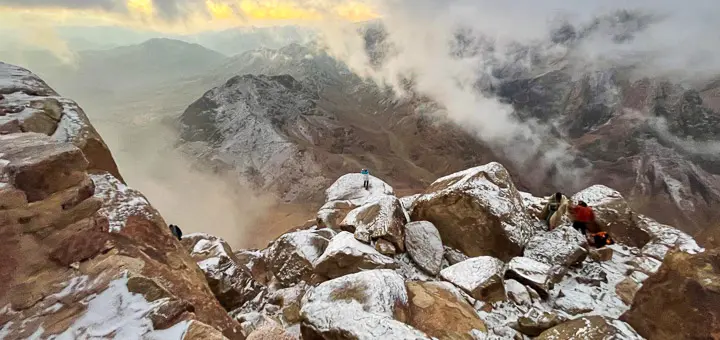
Morning light over Mount Sinai after fresh snowfall | Egypt Mountains | © Sinai Hikes.
Egypt Mountains might look dry and harsh, but look closer – life is there. Small shrubs, wild herbs, and desert flowers grow between rocks. Trees like acacia survive with almost no rain. Animals like the Sinai baton blue butterfly, one of the rarest in the world, live on one single type of thyme found only on certain mountain slopes.
In Mount Elba, in the far south, the air is cooler, and you’ll even find mist, ferns, and fig trees. It’s one of the greenest places in Egypt, thanks to sea fog that rolls in and feeds the soil. Some people don’t believe it until they see it. A forest in the desert? But yes, it exists. And it has been feeding people, animals, and stories for centuries.
Why It All Matters
Egypt Mountains aren’t empty. They’re filled with memories, traditions, healing, and life. Some carry old prayers in the wind. Others hold stories in their rocks. And while they might not be crowded or famous like the pyramids, they’re alive in a different way – a quieter, slower, but no less powerful way.
- For locals, they’re home.
- For travelers, they escape.
- And for Egypt, it’s history, nature, and spirit all standing still.
Conclusion: Exploring the Mountains of Egypt
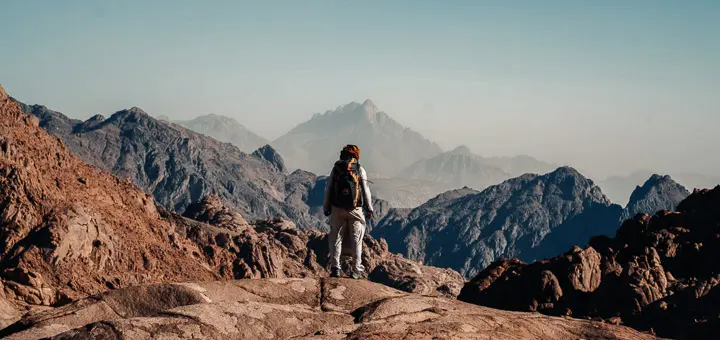
Bedouin guide overlooking Sinai Mountains | Egypt Mountains | © Sinai Hikes.
Egypt Mountains aren’t as loud or famous as the pyramids. They don’t show up on postcards or in travel ads. But if you ever stand on one or walk in its shade, something shifts. You notice how quiet the world can be. How big it feels. And how small, in a good way, you are. From the rocky trails of Sinai to the green ridges near Mount Elba, these places are full of more than views. They carry stories. Memories. People’s lives. Local tribes like the Bedouins of the Gibalya in Sinai or Ababda in Southern Egypt don’t need to “explore” these mountains; they live with them. They follow the same paths their grandparents walked. They tell stories about certain rocks, certain trees, and certain springs.
This isn’t tourism. It’s tradition. And for visitors like us, these mountains offer something rare: space to breathe. To reset. To remember there’s more to life than rushing and scrolling. You won’t need much, just some time, maybe good shoes, and an open mind. And if you want to do it right, go with people who know these lands. Sinai Hikes helps connect you to those who walk these paths every day, not just for work, but for life.
The Egypt Mountains won’t ask anything from you. But it might leave you with silence, wonder, or maybe just a better version of yourself.
You May Also Like

St Catherine Mountain: Why is Egypt’s Highest Peak So Special
Standing at 2,642 meters, St Catherine Mountain is Egypt’s highest peak and a favorite destination for adventurers and travelers alike. Its tranquil surroundings make it perfect for those in search of a serene retreat, offering chances to reflect, connect with nature, and create lasting memories (and of course, capture countless photos). What is Mount […]
Read More

Mount Sinai: Sacred History and Breathtaking Views
Mount Sinai is one of the top attractions in the Sinai Peninsula, and mountain climbing here is by far the most rewarding experience for adventure seekers. Whether you plan on taking in multiple peaks as part of an extended hike or simply fancy a climb up one mountain in particular, this article will introduce the […]
Read More

Multi-Day Hikes in Sinai: Your Ultimate Trekking Guide
In a world that revolves around screentime and vanity metrics, Sinai’s rugged landscapes and ancient pathways offer an escape from the hustle and bustle of modern life. If you’re an outdoor lover, seeking a new adventure away from the busy city life, Egypt’s Sinai is the place for you. The heavenly destination offers multi-day hikes […]
Read More


